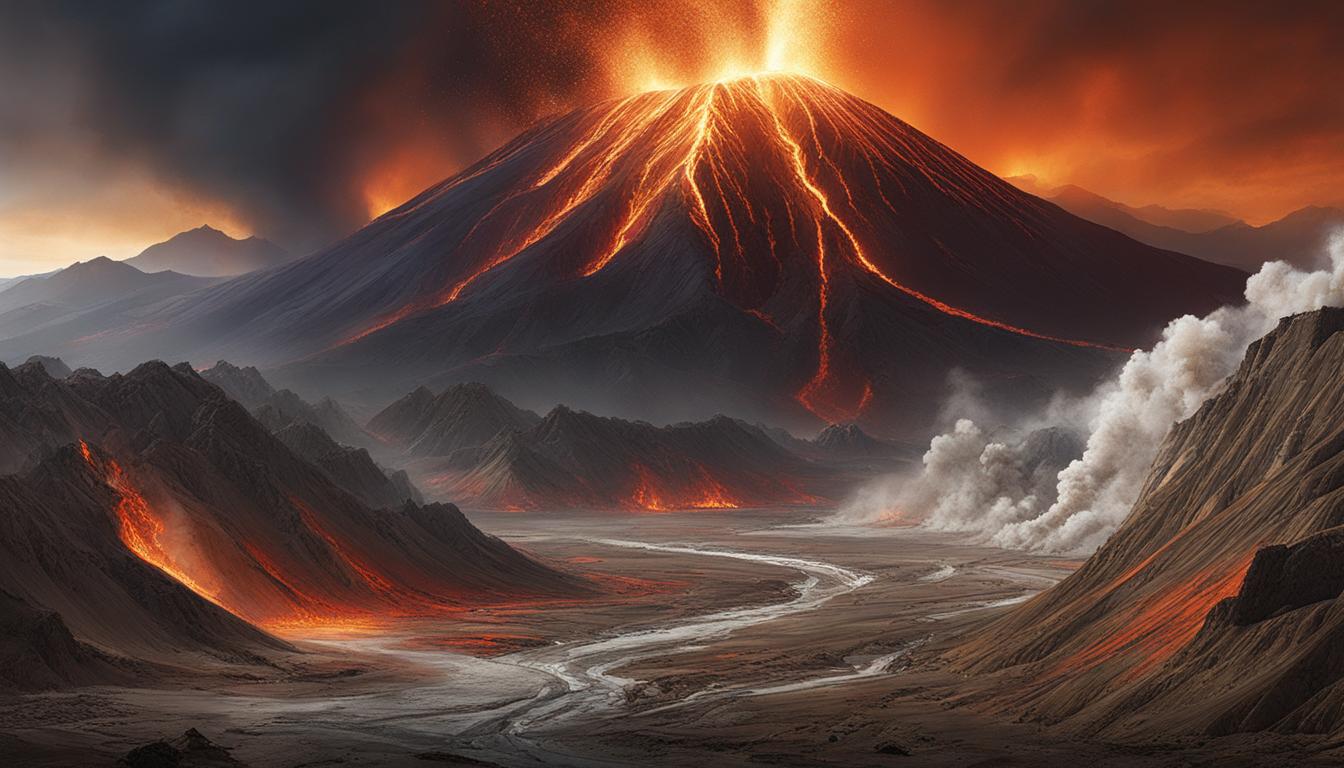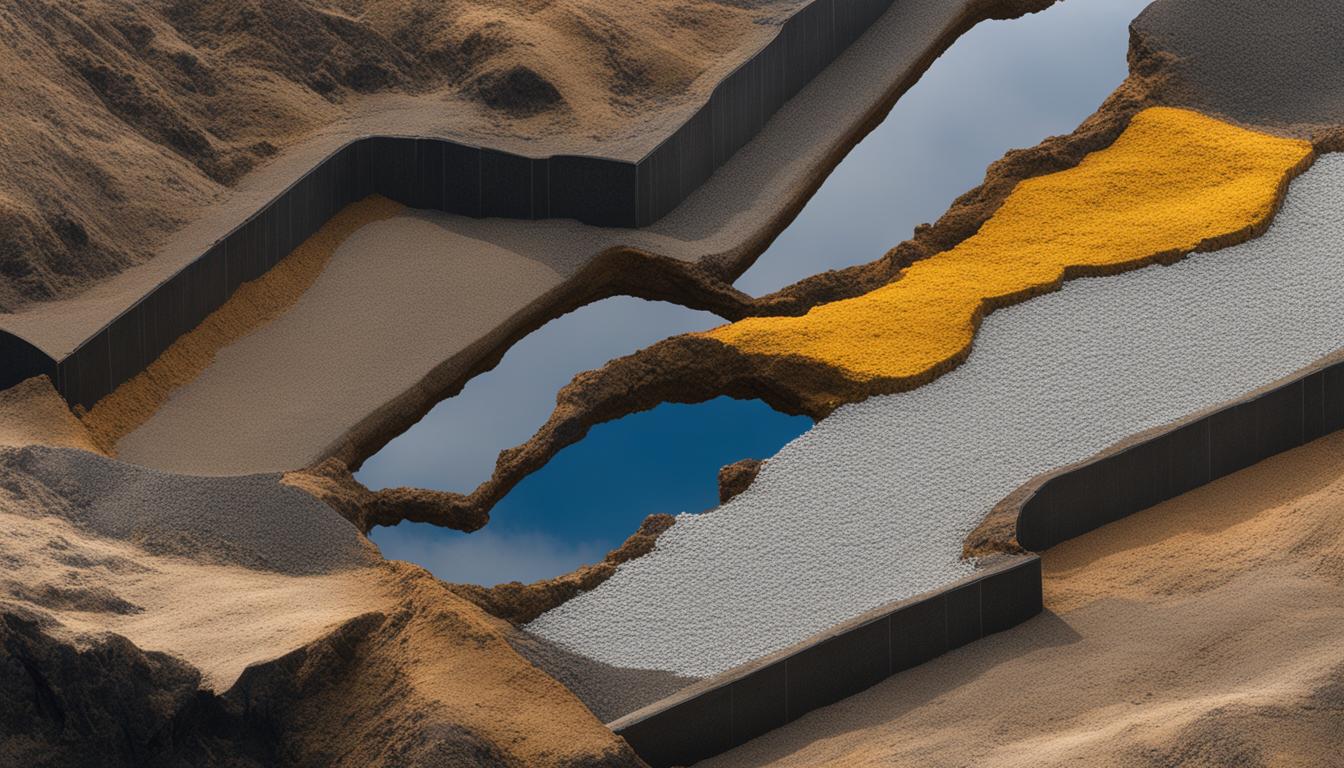Volcanic eruptions are powerful natural events that can have devastating consequences. Two of the most destructive phenomena associated with volcanic activity are lahars and pyroclastic flows. While both lahars and pyroclastic flows can cause significant damage, they differ in their composition, formation, and characteristics.
Lahars are mixtures of water and rock fragments that flow down the slopes of a volcano. They can occur with or without a volcanic eruption and are triggered by various factors such as melting snow and ice, rainfall, or landslides. Lahars can move at high speeds and cause serious damage to structures, as well as lead to severe flooding in downstream areas.
On the other hand, pyroclastic flows are deadly avalanches consisting of hot volcanic gases, ash, and rock. These flows can reach incredibly high speeds and temperatures. They have the power to destroy buildings, flatten trees, and have been responsible for the deaths of thousands of people throughout history.
Key Takeaways:
- Lahars and pyroclastic flows are powerful phenomena associated with volcanic eruptions.
- Lahars are mixtures of water and rock fragments that flow down the slopes of a volcano, while pyroclastic flows are deadly avalanches consisting of hot volcanic gases, ash, and rock.
- Lahars can occur with or without a volcanic eruption and can be triggered by various factors, including melting snow and ice, rainfall, or landslides.
- Pyroclastic flows are incredibly dangerous due to their high speed and temperature, causing massive destruction.
- Both lahars and pyroclastic flows pose significant hazards to human life and infrastructure.
Pyroclastic Flows: Origins, Properties, and Impacts
Pyroclastic flows are a type of volcanic hazard that forms during explosive eruptions or the collapse of a lava dome. Composed of pulverized rock, ash, and volcanic gases, these deadly avalanches can reach speeds of up to 450 miles per hour on steep volcanoes, with temperatures soaring up to 1000°C. The immense power of pyroclastic flows can cause widespread destruction, flattening buildings, and decimating vegetation in their path. One of the most infamous pyroclastic flow events in history occurred during the eruption of Mount Vesuvius in 79 AD, where the city of Pompeii was buried under a layer of ash and debris.
Pyroclastic flows present significant hazards to human life and infrastructure due to their high speed and incredible heat. They have been responsible for the deaths of over 90,000 people since 1600 AD. These devastating events can completely erase entire communities and leave behind a landscape of desolation. Understanding the formation, properties, and impacts of pyroclastic flows is crucial for mitigating their destructive effects and ensuring the safety of populations living near active volcanoes.
To better prepare for pyroclastic flow hazards, scientists and officials worldwide focus on the development of advanced warning systems and forecasting techniques. These systems monitor volcanic activity and issue timely alerts to at-risk populations, allowing for evacuations and mitigating the loss of life. Ongoing research in flow dynamics and modeling also contributes to our understanding of pyroclastic flows, enabling scientists to develop accurate predictions and improve preparedness measures. By studying the origins, properties, and impacts of pyroclastic flows, we can enhance our ability to protect lives and minimize the destruction caused by these awe-inspiring natural phenomena.
Lahars: Origins, Properties, and Impacts
Lahars are a unique natural phenomenon that poses significant hazards and impacts on both human life and the environment. Understanding the formation process, differences, and comparisons of lahars is crucial for ensuring the safety of communities living near active volcanoes.
Lahars are primarily formed when pyroclastic flows, consisting of hot volcanic gases, ash, and rock, come into contact with water. This water can be from sources such as melting snow and ice, rainfall, landslides, or the overflow of water across natural dams. The resulting mixture of water and rock fragments creates lahars, which are known for their ability to pick up and carry large amounts of debris, including rocks, soil, vegetation, and even buildings.
Lahars are characterized by their high speed, which can reach up to 200 km/hr, and their devastating impacts. They have the potential to cause serious damage to structures and infrastructure, burying them partially or completely. Moreover, lahars can lead to severe flooding in downstream areas, depositing large amounts of sediment and causing chronic flooding.
Lahar Formation Process
The formation process of lahars involves the interaction between volcanic material and water, leading to the creation of a fast-flowing mixture that can travel long distances from the volcano. This process can occur with or without an actual volcanic eruption, making lahars a unique phenomenon that can pose risks even in the absence of explosive eruptions.
| Lahar Formation Process | Description |
|---|---|
| Contact between pyroclastic flows and water | Pyroclastic flows, consisting of hot volcanic gases, ash, and rock, come into contact with water from various sources. |
| Water and volcanic material mix | The water mixes with the volcanic material, creating a slurry-like mixture that flows down the slopes of the volcano. |
| Debris accumulation | The lahars pick up and carry large amounts of debris, including rocks, soil, vegetation, and buildings, as they flow downhill. |
| Lahar movement | Lahars move at high speeds, reaching up to 200 km/hr, causing extensive damage to structures, infrastructure, and downstream areas. |
Given the destructive potential of lahars, it is essential to implement mitigation measures and develop effective preparedness strategies to minimize their impacts. Early warning systems and proactive evacuation plans can help safeguard vulnerable populations and reduce the loss of life and property caused by lahars.
In conclusion, lahars are formed when pyroclastic flows mix with water, resulting in fast-flowing mixtures that are capable of causing significant destruction and severe flooding. Understanding the formation process, differences, and comparisons of lahars is crucial for ensuring the safety of communities living near active volcanoes.

Lahars vs Pyroclastic Flows: Differences and Similarities
Lahars and pyroclastic flows are both destructive volcanic phenomena that pose significant hazards to human life and infrastructure. While they share some similarities in terms of their potential for destruction, there are key differences in their composition and formation.
Lahars are formed when water mixes with volcanic material, such as ash and rock fragments, resulting in a mixture that flows down the slopes of a volcano. They can occur with or without a volcanic eruption and can be triggered by factors such as melting snow and ice, rainfall, or landslides. Lahars are characterized by their high speed and ability to pick up and carry large amounts of debris, causing severe damage to structures and leading to flooding in downstream areas.
Pyroclastic flows, on the other hand, are composed of hot volcanic gases, ash, and rock. They are formed during explosive eruptions or the collapse of a lava dome. Pyroclastic flows can reach speeds of up to 450 miles per hour and have temperatures of up to 1000°C. These deadly avalanches can flatten trees, destroy buildings, and have caused the deaths of thousands of people throughout history.
While lahars and pyroclastic flows differ in their composition and formation, they both have the potential to cause significant loss of life and destruction. Examples of lahars include the devastating mudflows that occurred during the eruption of Mount St. Helens in 1980, while pyroclastic flows are famously associated with the eruption of Mount Vesuvius in 79 AD.
| Lahars | Pyroclastic Flows |
|---|---|
| Formed when water mixes with volcanic material | Composed of hot volcanic gases, ash, and rock |
| Can occur with or without a volcanic eruption | Formed during explosive eruptions or collapse of a lava dome |
| Can be triggered by melting snow and ice, rainfall, or landslides | Can reach speeds of up to 450 miles per hour |
| High speed, picks up and carries debris, causes severe damage to structures | Can flatten trees, destroy buildings, and cause mass destruction |
Key Differences between Lahars and Pyroclastic Flows:
- Lahars are formed when water mixes with volcanic material, while pyroclastic flows are composed of hot volcanic gases, ash, and rock.
- Lahars can occur with or without a volcanic eruption, while pyroclastic flows are formed during explosive eruptions or the collapse of a lava dome.
- Lahars can be triggered by factors such as melting snow and ice, rainfall, or landslides, while pyroclastic flows can reach speeds of up to 450 miles per hour.
- Lahars have the ability to pick up and carry large amounts of debris, causing severe damage to structures and leading to flooding in downstream areas, while pyroclastic flows can flatten trees, destroy buildings, and cause mass destruction.
Understanding the differences and similarities between lahars and pyroclastic flows is crucial for mitigating their impacts and ensuring the safety of communities living near active volcanoes. Ongoing research and improved forecasting techniques can further enhance our ability to predict and mitigate the dangers posed by these destructive volcanic phenomena.
Lahar and Pyroclastic Flow Hazards: Impact on Human Life and the Environment
Lahars and pyroclastic flows pose significant hazards to human life and the environment. These natural disasters can cause the loss of human lives, destroy buildings and infrastructure, and trap people in hazardous areas. The impact of lahars and pyroclastic flows extends beyond immediate destruction. Lahars, for example, can lead to severe flooding in downstream areas, causing additional damage and displacing communities. The high speed and ability of lahars to carry large amounts of debris can result in extensive damage to structures and infrastructure.
Pyroclastic flows, on the other hand, are known for their devastating power. They consist of hot volcanic gases, ash, and rock, moving at speeds of up to 450 miles per hour. Pyroclastic flows can flatten trees, destroy buildings, and cause mass destruction. The deaths of over 90,000 people since 1600 AD can be attributed to pyroclastic flows, highlighting their deadly nature.
Both lahars and pyroclastic flows have long-lasting impacts on the environment. These natural disasters can alter landscapes, deposit large amounts of sediment in rivers and streams, and cause chronic flooding. The economic and environmental damage caused by lahars and pyroclastic flows is extensive, necessitating significant recovery efforts. Understanding and mitigating the hazards posed by these phenomena is crucial for protecting lives and reducing the long-term impact on the environment.
Table: Comparison of Lahar and Pyroclastic Flow Hazards
| Hazard | Lahars | Pyroclastic Flows |
|---|---|---|
| Composition | Mixtures of water and rock fragments | Hot volcanic gases, ash, and rock |
| Speed | Up to 200 km/hr | Up to 450 miles per hour |
| Impact | Damage to structures, severe flooding | Flattening of trees, destruction of buildings |
| Environmental Impact | Alteration of landscapes, chronic flooding | Alteration of landscapes, deposition of sediment |
Both lahars and pyroclastic flows require careful monitoring, research, and preparedness to mitigate their hazards. With improved detection systems and forecasting techniques, early warning signals can be provided to communities at risk, allowing for timely evacuations and minimizing the loss of life. Ongoing research into the flow dynamics and behavior of lahars and pyroclastic flows contributes to the development of effective strategies and technologies to reduce their destructive impacts. By understanding the hazards they pose and implementing appropriate measures, we can work towards safer communities living near active volcanoes.
Mitigation and Preparedness
The potential hazards and destructive nature of lahars and pyroclastic flows necessitate the implementation of effective mitigation and preparedness measures. Scientists and officials have developed specialized systems and strategies to detect and warn against these natural disasters, minimizing their impact on human life and infrastructure.
Lahar Detection Systems
Lahar detection systems play a crucial role in providing early warnings and alerts in the event of an impending lahar. These systems rely on advanced technologies, such as ground-based sensors and satellite imagery, to monitor volcanic activity and detect signs of lahars. By analyzing changes in ground deformation, gas emissions, and seismic activity, these systems can issue timely alerts to at-risk communities, allowing for the evacuation of vulnerable populations and the implementation of safety measures.
Pyroclastic Flow Warning Systems
Similar to lahars, pyroclastic flows require robust warning systems to protect lives and property. These warning systems utilize a combination of volcano monitoring techniques, including seismic monitoring, gas analysis, and thermal imaging, to detect and forecast pyroclastic flow events. When volcanic activity indicates a potential pyroclastic flow, early warning messages are disseminated through various channels, such as sirens, text messages, and public announcements, enabling residents in high-risk areas to evacuate promptly and seek shelter in safer locations.
By implementing and maintaining these detection and warning systems, communities living near active volcanoes can enhance their preparedness and response capabilities. The prompt evacuation of vulnerable populations and the dissemination of accurate information can save lives and mitigate the devastating effects of lahars and pyroclastic flows.

Table: Comparison of Lahar Detection Systems and Pyroclastic Flow Warning Systems
| Criteria | Lahar Detection Systems | Pyroclastic Flow Warning Systems |
|---|---|---|
| Monitoring Technologies | Ground-based sensors, satellite imagery | Seismic monitoring, gas analysis, thermal imaging |
| Warning Signals | Alerts issued through sirens, text messages, public announcements | Early warning messages disseminated via sirens, text messages, public announcements |
| Primary Purpose | Detect and warn against impending lahars | Detect and forecast pyroclastic flow events |
| Key Benefits | Timely evacuation of vulnerable populations, implementation of safety measures | Prompt evacuation, dissemination of accurate information |
The Importance of Research and Forecasting
Understanding the dynamics of lahars and pyroclastic flows is crucial for mitigating their devastating impacts and ensuring the safety of communities living near active volcanoes. This is where research and forecasting come into play. Scientists and researchers tirelessly study these natural phenomena to observe, quantify, and model their behavior, enabling better preparedness and response strategies.
One key area of research is the flow dynamics of lahars. By studying how lahars move and interact with different terrains, scientists can develop accurate models that predict their path and potential impact. This information is invaluable in designing evacuation plans and determining safe zones in high-risk areas.
Pyroclastic flow forecasting is another critical aspect of research. Scientists closely monitor volcanic activity and analyze various factors like gas emissions, seismicity, and ground deformation to predict the occurrence and behavior of pyroclastic flows. Timely forecasts and warnings can save lives, allowing people in at-risk areas to evacuate before the flows occur.
“Research and forecasting play a vital role in protecting communities from the destructive forces of lahars and pyroclastic flows. By advancing our understanding of these phenomena, we can develop better warning systems, evacuation plans, and infrastructure strategies, ultimately reducing the loss of life and minimizing the economic and environmental damage.”
Through ongoing research and technological advancements, scientists aim to enhance our ability to predict, monitor, and mitigate the dangers posed by lahars and pyroclastic flows. This includes the development of more sophisticated detection systems, improved modeling techniques, and the integration of real-time data into forecasting algorithms. Investing in research and forecasting efforts is essential in ensuring the safety and resilience of communities living in volcanic areas.
Lahar Flow Dynamics Table
| Factors | Effect on Lahar Flow Dynamics |
|---|---|
| Terrain | Determines the speed, direction, and spreading pattern of the lahar flow |
| Volume of Water | Affects the speed and velocity of the lahar flow |
| Composition of Sediment | Influences the viscosity and erosive capacity of the lahar flow |
| Obstacles and Channel Constrictions | Can cause the lahar flow to dam up, overflow, or change direction |
Understanding the various factors that influence lahars’ flow dynamics is crucial for predicting their behavior and potential impact. By studying the terrain, volume of water, composition of sediments, and obstacles in the lahar’s path, scientists can develop accurate models that assist in risk assessment and mitigation strategies.
Conclusion
In conclusion, lahars and pyroclastic flows are both powerful and deadly phenomena associated with volcanic eruptions. Lahars are formed through the mixing of volcanic material with water, while pyroclastic flows consist of hot volcanic gases, ash, and rock. Although they differ in composition and formation, both lahars and pyroclastic flows have caused significant loss of life and destruction throughout history.
Understanding the differences and similarities between these phenomena is crucial for mitigating their impacts and ensuring the safety of communities living near active volcanoes. Scientists and officials have developed mitigation and preparedness measures such as lahar detection systems and pyroclastic flow warning systems to provide early warnings and evacuate vulnerable populations.
Nevertheless, ongoing research and improved forecasting techniques are essential in enhancing our ability to predict and mitigate the dangers posed by lahars and pyroclastic flows. By studying flow dynamics, forecasting, and developing improved warning systems, scientists can contribute to minimizing the destructive effects of these natural disasters and protecting lives and infrastructure.
FAQ
What are pyroclastic flows?
Pyroclastic flows are deadly avalanches consisting of hot volcanic gases, ash, and rock. They can reach speeds of up to 450 miles per hour on steep volcanoes and have temperatures of up to 1000°C.
What causes pyroclastic flows?
Pyroclastic flows are formed during explosive eruptions or the collapse of a lava dome. They consist of pulverized rock, ash, and volcanic gases.
What are lahars?
Lahars are hot or cold mixtures of water and rock fragments that flow down the slopes of a volcano. They can occur with or without a volcanic eruption and can be triggered by melting snow and ice, rainfall, or landslides.
How fast do lahars move?
Lahars can move at speeds of up to 200 km/hr.
What are the similarities between pyroclastic flows and lahars?
Both pyroclastic flows and lahars can cause serious damage to structures and infrastructure, leading to loss of life and destruction.
What is the most famous pyroclastic flow event?
The most famous pyroclastic flow occurred during the eruption of Mount Vesuvius in 79 AD, which buried the city of Pompeii.
Can lahars lead to flooding?
Yes, lahars can lead to severe flooding in downstream areas, depositing large amounts of sediment and causing chronic flooding.
How do scientists mitigate the impact of lahars and pyroclastic flows?
Scientists have developed lahars and pyroclastic flow warning systems to provide early detection and timely warnings to at-risk populations. These systems help in evacuating vulnerable populations and ensuring public safety.
What is the importance of research on lahars and pyroclastic flows?
Research on lahars and pyroclastic flows helps scientists understand their behavior and develop accurate models and predictions. This knowledge contributes to improved forecasting techniques and the development of mitigating technologies and strategies.
 Skip to main content
Skip to main content


